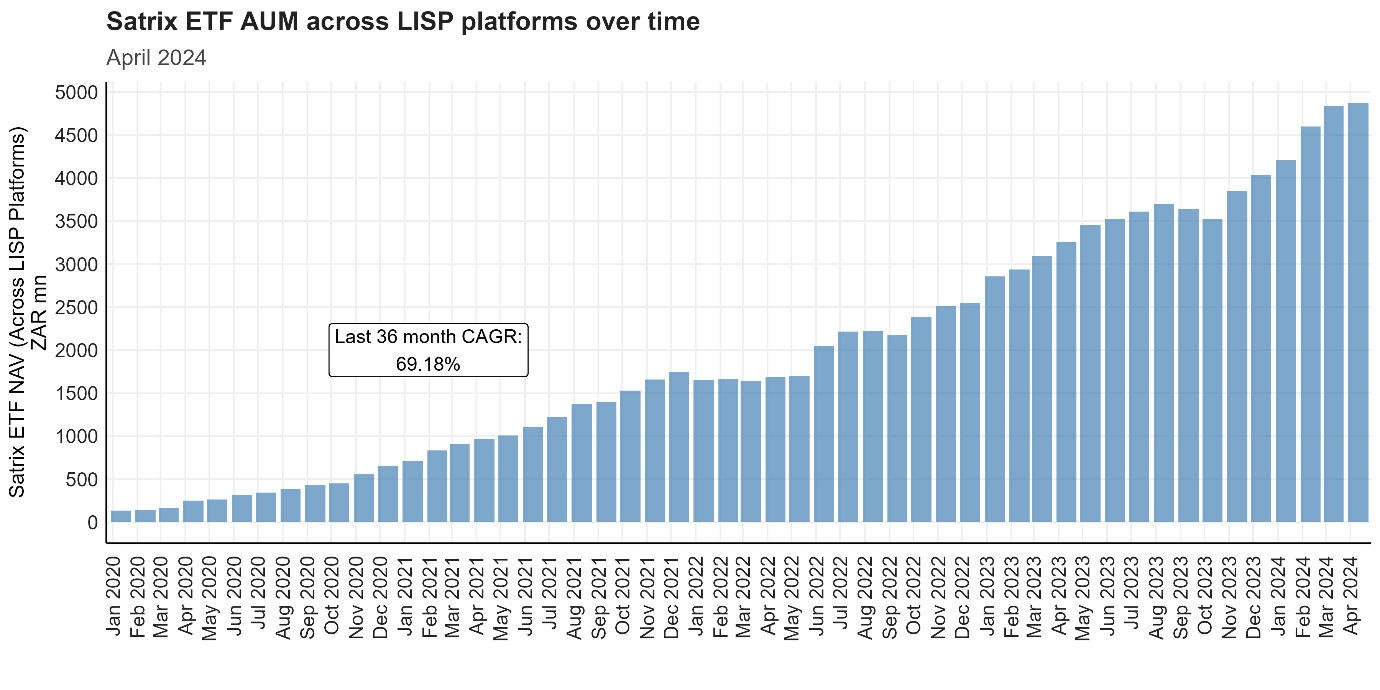ETFs are designed to protect existing investors from the costs generated by others entering or exiting the fund, unlike Unit Trusts. This design feature shields long-term investors from external churn, safeguarding their performance and ensuring a fairer cost structure.
PwC's recent report, ETFs 2026: The Next Big Leap, reveals that 58% of respondents expect global exchange-traded fund (ETF) assets under management (AUM) to reach USD 18 trillion by 2026. Additionally, 84% anticipate that online platforms will become the primary source of future demand for ETFs. This global trend is mirrored in South Africa, where Satrix introduced the first ETF in 2000. Since then, these assets have seen significant inflows, making ETFs an increasingly popular investment option amid South Africa's challenging economic conditions.
Current Landscape and Growth
The South African ETF industry has experienced impressive growth. As of December 2023, the total ETF industry AUM, including commodities, reached R147.9 billion, a growth of 25.4% from the previous year. Satrix, specifically, has seen its ETF AUM grow from R25.5 billion in December 2020 to R52.3 billion in December 2023, reflecting a compound annual growth rate (CAGR) of 27.1% per annum, compared to the industry growth rate of 13.2% per annum.
We are still seeing very healthy flows into ETFs midway into 2024, with nearly R4 billion of net flows into the range of ETFs available in South Africa, with Satrix receiving 40% of these flows. This robust activity, despite some product consolidation, underscores the ongoing appeal and resilience of ETFs.
Here’s why ETFs should be an attractive option for financial advisers to diversify client portfolios:
Greater Certainty
ETFs employ rules-based or systemic strategies, offering clients greater transparency and consistency in their investment choices. These strategies rebalance back to their stated objectives, providing clients with the confidence that they will always get what’s on the label. This predictability builds greater investor confidence.
Compelling Medium- to Long-Term Performance
The arithmetic of active management suggests that, after accounting for higher fees and transaction costs, the average actively managed rand will underperform the average broad-market indexed rand. While an index fund might slightly underperform the market benchmark it tracks, its cost-effectiveness often leads to significantly better-than-median returns over the medium to long term. The lower costs associated with index-based ETFs can significantly improve overall investment outcomes through the consistent compounding of lower fees.
Unique Cost Structure
ETFs are designed to protect existing investors from the costs generated by others entering or exiting the fund, unlike Unit Trusts. This design feature shields long-term investors from external churn, safeguarding their performance and ensuring a fairer cost structure.
The Changing Tide
Five to ten years ago, there was considerable scepticism regarding the adoption of ETFs in South Africa due to the unique characteristics of our market. However, with over two decades of index history now available for analysis, ETFs have proven their worth. We’ve also seen robust growth in the take-up of ETFs, since being made available on Linked Investment Service Provider (LISP) platforms. The last three years saw AUM grow five-fold, from just below R1 billion to nearly R5 billion. The arithmetic of active management is becoming more evident to advisers and investors, further boosting the case for ETFs.

ETFs for Risk Mitigation and Diversification
In volatile markets, ETFs provide significant benefits for risk mitigation through diversification. The increased range of investment strategy choices across different asset classes or even multi-asset class (balanced) ETFs allows advisers to construct well-diversified portfolios for clients, that capture their desired themes. For example, advisers can employ a low volatility local equity strategy through the Satrix Low Volatility ETF or gain high rand-hedge exposure for clients via the Satrix JSE Global Equity ETF. Defensive options include interest-bearing ETFs like the Satrix Local Bond ETF and Satrix Global Bond ETF.
Offshore and Local Exposure
ETFs offer both offshore and local exposure. For example, the Satrix MSCI ACWI ETF tracks the MSCI All Country World Index, providing exposure to over 2 800 companies across 23 developed and 24 emerging markets. Other options include thematic strategies like the Satrix Nasdaq 100 Feeder ETF for technological innovation and the Satrix MSCI World ESG Enhanced Feeder ETF for climate transition and ESG investing.
The ETF boom in South Africa is multi-faceted, driven by cost efficiency, performance, and accessibility. As advisers, understanding these drivers will help you guide your clients better and offer a broader palette of effective investment strategies.
*Satrix is a division of Sanlam Investment Management.
Disclaimer
Satrix Investments (Pty) Ltd is an approved financial service provider in terms of the Financial Advisory and Intermediary Services Act, No 37 of 2002 (“FAIS”). The information above does not constitute financial advice in terms of FAIS. Consult your financial adviser before making an investment decision. While every effort has been made to ensure the reasonableness and accuracy of the information contained in this document (“the information”), the FSP, its shareholders, subsidiaries, clients, agents, officers and employees do not make any representations or warranties regarding the accuracy or suitability of the information and shall not be held responsible and disclaim all liability for any loss, liability and damage whatsoever suffered as a result of or which may be attributable, directly or indirectly, to any use of or reliance upon the information.
Satrix Managers (RF) (Pty) Ltd (Satrix) is a registered and approved Manager in Collective Investment Schemes in Securities. Collective investment schemes are generally medium- to long-term investments. With Unit Trusts and ETFs, the investor essentially owns a “proportionate share” (in proportion to the participatory interest held in the fund) of the underlying investments held by the fund. With Unit Trusts, the investor holds participatory units issued by the fund while in the case of an ETF, the participatory interest, while issued by the fund, comprises a listed security traded on the stock exchange. ETFs are index tracking funds, registered as a Collective Investment and can be traded by any stockbroker on the stock exchange or via Investment Plans and online trading platforms. ETFs may incur additional costs due to being listed on the JSE. Past performance is not necessarily a guide to future performance and the value of investments / units may go up or down. A schedule of fees and charges, and maximum commissions are available on the Minimum Disclosure Document or upon request from the Manager. Collective investments are traded at ruling prices and can engage in borrowing and scrip lending. Should the respective portfolio engage in scrip lending, the utility percentage and related counterparties can be viewed on the ETF Minimum Disclosure Document. A feeder fund is a portfolio that invests in a single portfolio of a collective investment scheme, which levies its own charges and which could result in a higher fee structure for the feeder fund. International investments or investments in foreign securities could be accompanied by additional risks such as potential constraints on liquidity and repatriation of funds, macroeconomic risk, political risk, foreign exchange risk, tax risk, settlement risk as well as potential limitations on the availability of market information.
For more information, visit https://satrix.co.za/products


